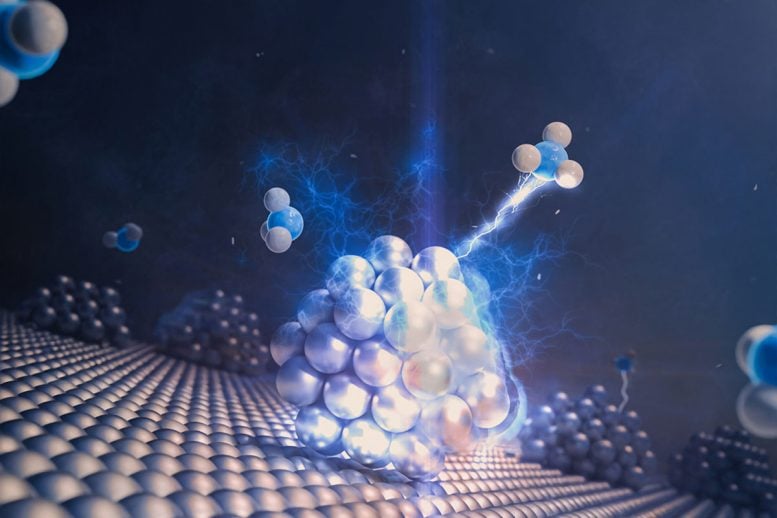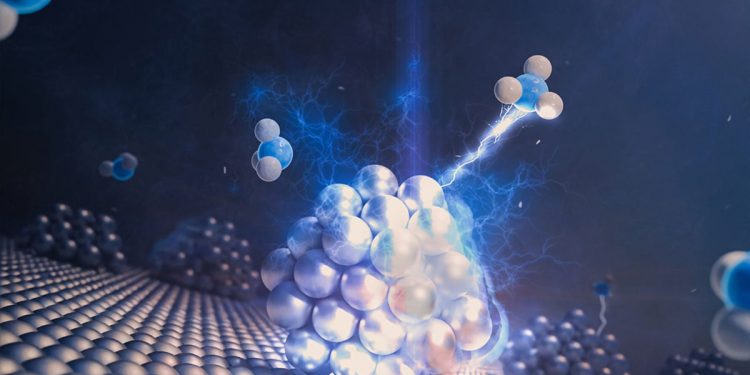
This discovery could significantly reduce the production costs of fuels, chemicals and materials.
A research team from the University of Minnesota’s Twin Cities College of Science and Engineering and the University of Houston’s Cullen College of Engineering has identified and measured for the first time the tiny fraction of an electron that enables catalytic manufacturing.
Details of the work appear in the open access journal ACS Central Science. The results clarify why precious metals such as gold, silver and platinum are so effective in catalysis and offer guidance for creating next-generation catalytic materials.
Catalysts are substances that reduce the energy required for chemical reactions. In doing so, they help manufacturers increase yield, speed and efficiency when manufacturing other materials. These tools are at the heart of processes used in pharmaceutical and battery production, as well as petrochemical operations such as crude oil refining, helping supply keep pace with demand.
Finding catalysts that work faster and are easier to control is a primary goal in the fuels, chemicals and materials industries, which together represent billions of dollars in savings. Researchers around the world are working to develop enablers that can reduce costs and improve manufacturing efficiency across many industries.
Understand how molecules interact with catalysts
When molecules approach the surface of a catalyst, they share their electrons with the catalytic metal (in this case, gold, silver, or platinum), thereby stabilizing the molecules in such a way that the desired reactions occur. This concept has been theorized for over a century, but direct measurements of these tiny, highly consequential percentages of an electron have never been directly observed.
Researchers at the Center for Programmable Energy Catalysis, headquartered at the University of Minnesota, have now shown that electron sharing can be directly measured by a technique of their own invention called isopotential electronic titration (IET).
“Measuring fractions of electrons at these incredibly small scales provides the clearest view yet of how molecules behave on catalysts,” said Justin Hopkins, a PhD in chemical engineering at the University of Minnesota. student and lead author of the research study. “Historically, catalyst engineers relied on more indirect measurements under idealized conditions to understand molecules on surfaces. Instead, this new measurement method provides a tangible description of surface binding under catalytically relevant conditions.”
Determining the amount of electron transfer at the surface of a catalyst is essential to understanding its performance. Molecules more inclined to share their electrons bind more strongly, with increasing reactivity, providing a directly measurable amount for catalyst activity. Precious metals exhibit the precise extent of electron sharing with reactant molecules necessary to drive catalysis, although this exchange has not been possible to measure directly until today.
The power of electronic isopotential titration (EET)
IET can now serve as a tool for experimental description of new catalyst formulations, which will allow researchers to search for and discover ideal catalytic substances more quickly.
“IET allowed us to measure the fraction of an electron shared with the surface of a catalyst at levels even below 1%, such as in the case of a hydrogen atom. atom on platinum,” said Omar Abdelrahman, corresponding author and associate professor in the department of chemical and biomolecular engineering in the Cullen College of Engineering at the University of Houston Cullen. “A hydrogen atom gives up only 0.2 percent of an electron when it binds to platinum catalysts, but it is this small percentage that allows the hydrogen to react in the manufacture of products industrial chemicals.”
With the emergence of catalyst synthesis nanotechnologies combined with new tools in machine learning To explore and use large data sets, engineers have identified a large number of new catalytic materials. IET now allows a third method to directly characterize new materials at a fundamental level.
“The basis of new catalytic technologies for industry has always been fundamental basic research,” says Paul Dauenhauer, professor emeritus and director of the Center for Programmable Energy Catalysis at the University of Minnesota. “This new discovery of fractional electron distribution establishes a completely new scientific basis for understanding the catalysts that we believe will drive new energy technologies in the coming decades.”
Reference: “Isopotential Electron Titration: Hydrogen Adsorbate-Metal Charge Transfer” by Justin A. Hopkins, Benjamin J. Page, Shengguang Wang, Jesse R. Canavan, Jason A. Chalmers, Susannah L. Scott, Lars C. Grabow, James R. McKone, Paul J. Dauenhauer and Omar A. Abdelrahman, 15 September 2025, ACS Central Science.
DOI: 10.1021/acscentsci.5c00851
Funding: U.S. Department of Energy
Never miss a major breakthrough: join the SciTechDaily newsletter.
Follow us on Google, Discover and News.









